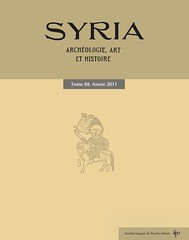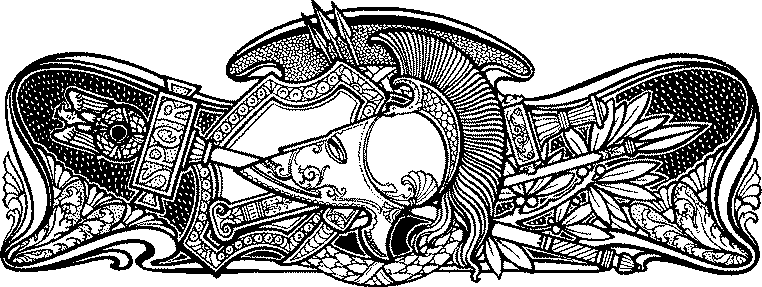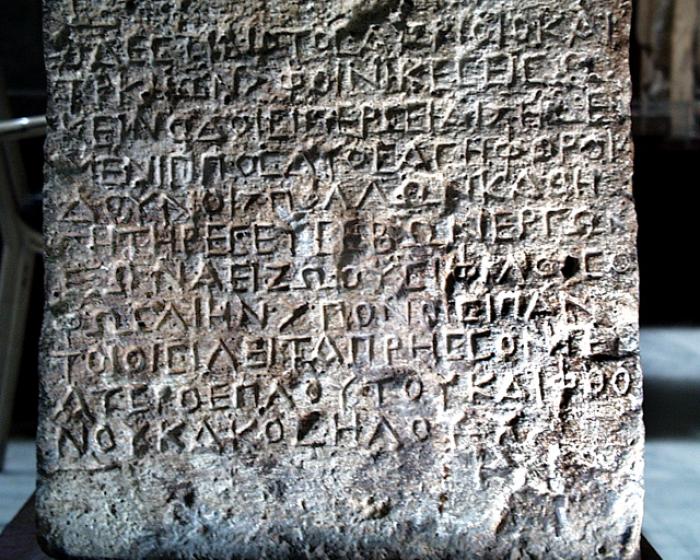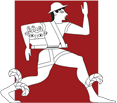[First posted in AWOL 26 August 2009. Updated 15 May 2017]
Syria. Archéologie, Art et histoire
eISSN: 2076-8435
Syria. Archéologie, Art et histoire
ISSN format papier:0039-7946
eISSN: 2076-8435
Syria. Archéologie, Art et histoire
eISSN: 2076-8435
Depuis 1920, la revue Syria. Archéologie, art et histoire est publiée par l’Institut français du Proche-Orient (Ifpo) avec le concours du CNRS. La revue se consacre à l’histoire ancienne et à l’archéologie du Proche-Orient, Chypre compris. De la préhistoire au viie siècle et de la Méditerranée au plateau iranien, Syria traite d’archéologie, d’épigraphie, de philologie, d’histoire et d’histoire de l’art.
Derniers numéros
Documents nouveaux et méconnus[Texte intégral disponible en novembre 2018]
La dédicace de Vaison-la-Romaine au Bel d’Apamée (CIL XII, 1277)[Texte intégral disponible en novembre 2018]Autres articles
Les exemples de Dharih (Jordanie) et de Qalhāt (Oman)[Texte intégral disponible en novembre 2018]Variétés
Nécrologies
The Syria backlist (vol 1 (1920) - vol 82 (2005) is available at Persée:Numéros en texte intégral
- 91 | 2014
- 90 | 2013
Dossier : Recherches actuelles sur l’occupation des périphéries désertiques de la Jordanie aux périodes protohistoriques- 89 | 2012
- 88 | 2011
Dossier : La Steppe- 87 | 2010
- 86 | 2009
Dossier : Interaction entre Assyriens et Araméens- 85 | 2008
Dossier : L'eau dans la ville antique- 84 | 2007
- 83 | 2006
Hommage à Henri de ContensonSuppléments à Syria
Syria. Archéologie, Art et histoire
ISSN format papier:0039-7946
eISSN: 2076-8435
Syria, an annual journal, has been published uninterruptedly since 1920 by the French Institute of the Near East (Amman, Beirut, Damascus, Aleppo). The review is dedicated to the history and archaelogy of the Semitic Near East (Cyprus included) from Prehistory to the Islamic conquest. It publishes articles in all the disciplines related to this field of research, archaology, epigraphy, philology, history, art history ; these articles are sometimes gathered together in thematic issues, but usually each issue of Syria tries to give - by means of 12 to 18 articles -, a varied overview of research on the Ancient Near East. The languages in use are French, English, German, Italian, and Spanish. From time to time, the review also publishes topical notes, and normaly devotes in each issue an extensive section to reading notes on books published on the Ancient Near East.
Syria, qui paraît depuis 1920 sans interruption, est publiée par l’Institut Français du Proche-Orient, en une seule livraison annuelle. La revue se consacre à l’histoire et l’archéologie du Proche-Orient sémitique (y compris Chypre) de la préhistoire à la conquête islamique. Elle publie des articles dans toutes les disciplines de ce champ de recherche, archéologie, épigraphie, philologie, histoire, histoire de l’art ; ces articles peuvent être quelquefois regroupés en dossiers thématiques, mais le plus souvent chaque volume tente de donner, à travers 12 à 18 articles, un panorama varié de la recherche au Proche-Orient ancien. Les langues employées sont le français, l’anglais, l’allemand, l’italien et l’espagnol. Tous les articles sont précédés d’un résumé en français, en anglais et en arabe. La revue publie aussi à l’occasion de courtes notes d’actualité, et consacre dans chaque numéro un épais cahier aux recensions d’ouvrages parus sur le Proche-Orient ancien.
Available periods :
1920-1929
1930-1939
1940-1949
- 1940 : [ 21-1 ][ 21-2 ][ 21-3-4 ]
- 1941 : [ 22-1 ][ 22-2 ][ 22-3-4 ]
- 1942 : [ 23-1-2 ][ 23-3-4 ]
- 1944 : [ 24-1-2 ][ 24-3-4 ]
- 1946 : [ 25-1 ][ 25-3-4 ]
- 1949 : [ 26-1-2 ][ 26-3-4 ]
1950-1959
- 1950 : [ 27-1 ][ 27-3-4 ]
- 1951 : [ 28-1-2 ][ 28-3-4 ]
- 1952 : [ 29-1-2 ][ 29-3-4 ]
- 1953 : [ 30-1-2 ][ 30-3-4 ]
- 1954 : [ 31-1-2 ][ 31-3-4 ]
- 1955 : [ 32-1-2 ][ 32-3-4 ]
- 1956 : [ 33-1 ]
- 1957 : [ 34-1-2 ][ 34-3-4 ]
- 1958 : [ 35-1-2 ][ 35-3-4 ]
- 1959 : [ 36-1-2 ][ 36-3-4 ]
1960-1969
- 1960 : [ 37-1-2 ][ 37-3-4 ]
- 1961 : [ 38-1-2 ][ 38-3-4 ]
- 1962 : [ 39-1-2 ][ 39-3-4 ]
- 1963 : [ 40-1-2 ][ 40-3-4 ]
- 1964 : [ 41-1-2 ][ 41-3-4 ]
- 1965 : [ 42-1-2 ][ 42-3-4 ]
- 1966 : [ 43-1-2 ][ 43-3-4 ]
- 1967 : [ 44-1-2 ][ 44-3-4 ]
- 1968 : [ 45-1-2 ][ 45-3-4 ]
- 1969 : [ 46-1-2 ][ 46-3-4 ]
1970-1979
- 1970 : [ 47-1-2 ][ 47-3-4 ]
- 1971 : [ 48-1-2 ][ 48-3-4 ]
- 1972 : [ 49-1-2 ][ 49-3-4 ]
- 1973 : [ 50-1-2 ][ 50-3-4 ]
- 1974 : [ 51-1-2 ][ 51-3-4 ]
- 1975 : [ 52-1-2 ][ 52-3-4 ]
- 1976 : [ 53-1-2 ][ 53-3-4 ]
- 1977 : [ 54-1-2 ][ 54-3-4 ]
- 1978 : [ 55-1-2 ][ 55-3-4 ]
- 1979 : [ 56-1-2 ][ 56-3-4 ]
1980-1989
- 1980 : [ 57-1 ][ 57-2-4 ]
- 1981 : [ 58-1-2 ][ 58-3-4 ]
- 1982 : [ 59-1-2 ][ 59-3-4 ]
- 1983 : [ 60-1-2 ][ 60-3-4 ]
- 1984 : [ 61-1-2 ][ 61-3-4 ]
- 1985 : [ 62-1-2 ][ 62-3-4 ]
- 1986 : [ 63-1-2 ][ 63-3-4 ]
- 1987 : [ 64-1-2 ][ 64-3-4 ]
- 1988 : [ 65-1-2 ][ 65-3-4 ]
- 1989 : [ 66-1-4 ]
1990-1999
- 1990 : [ 67-1 ][ 67-2 ][ 67-3-4 ]
- 1991 : [ 68-1-4 ]
- 1992 : [ 69-1-2 ][ 69-3-4 ]
- 1993 : [ 70-1-2 ][ 70-3-4 ]
- 1994 : [ 71-1-2 ][ 71-3-4 ]
- 1995 : [ 72-1-2 ][ 72-3-4 ]
- 1996 : [ 73-1-4 ]
- 1997 : [ 74 ]
- 1998 : [ 75 ]
- 1999 : [ 76 ]
See AWOL's full List of Open Access Journals in Ancient Studies




 Corpus Inscriptionum Latinarum II2
Corpus Inscriptionum Latinarum II2 Astigitanus
Astigitanus Municipios antiguos de la CAM
Municipios antiguos de la CAM
 16.3 Mb >>
16.3 Mb >>


























